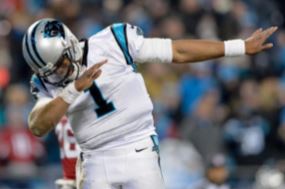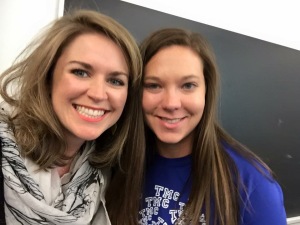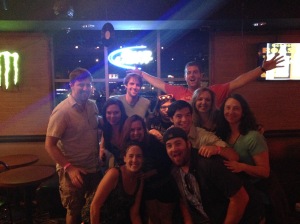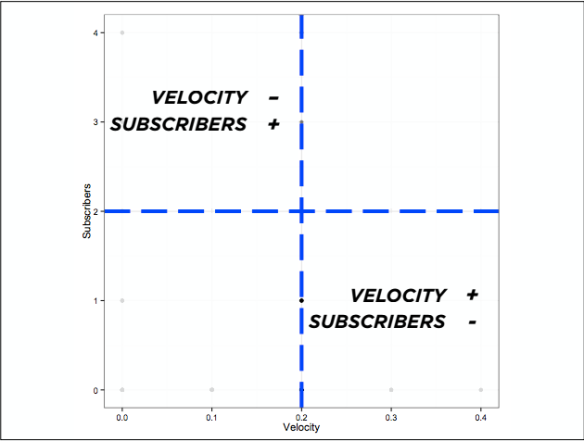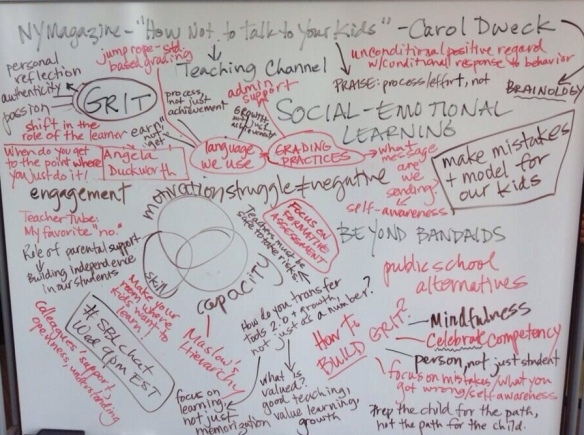A couple of weeks ago I came across this tweet on Twitter:
Since I had recently finished reading Instant Relevance: Using Today’s Experiences to Teach Tomorrow’s Lessons by Denis Sheeran, I knew I needed to have my PreCalculus students do this activity. We were days away from reviewing the trig ratios and I knew this would be an engaging and fun way to have them practice.
I quickly did some research on The Dab. Sports Illustrated published a helpful article on The Dab’s history in sports. While there is some disagreement over the originator of The Dab, most people agree it originated in the Atlanta hip-hop scene. There are also some fun celebrity videos in which people are taught to dab: Jason Derulo teaching James Corden around minute 7:05 and Ellen Degeneres teaching Hillary Clinton.
Then, I got to work putting together the actual lesson. Special shoutouts to Matt Vaudrey for his amazing Mullet Ratio lesson which inspired some of the format, and Lisa Bejarano for her feedback and input to the lesson itself.
The General Lesson Outline:
-Look at images of dabs and ask students which is the best one? Try to figure out what makes a dab, a dab.
-Continue debating. Is one dab dab-ier than another? The dab-iest?
-Calculate the dab angle of some famous people (gallery walk style around the classroom)
-Calculate their own dab angle
-Decide whether or not a “golden dab” angle exists
See slides below for a better understanding of the lesson flow:
PDF Version of slides: golden-dab
Powerpoint Version of slides: golden-dab
What actually happened?
Most students were immediately engaged in The Dab Debate and had an opinion of which dab they liked the best. However, a few immediately told me that The Dab was dying (or was already dead according to which student was asked). This was sad to hear. But there were enough students thoroughly debating for their favorite dab that the “silliness” of the conversation took over the room and we proceeded at full speed ahead.
I quickly learned that I had a very different opinion of what makes a really good dab than my students do. For example, I don’t particularly like Cam Newton’s dab because his arm lines have different slopes:
However, my students immediately told me that the second arm doesn’t matter. Doesn’t matter AT ALL. This kinda blew my mind. In fact, sometimes it looks like the person is trying too hard if the arms match perfectly. Such as tennis player Victoria Azarenka:

I think her dab is great. My students on the other hand, said things like: “She forced it.” “She looks like she practiced that for hours.” They are a tough crowd, but know much more about The Dab than me, so they are the experts here.
I asked for some clarification on having both arms line up. This is okay sometimes. It was hard for them to describe, but they were very adamant that it couldn’t look like you were trying to hard. Their dab advice: Look confident. Look comfortable. Be natural. Just hit it.
So, with that advice, we set about measuring and calculating the dab angle of Cam Newton together. Ignoring the second arm, the triangle we drew looked like this:
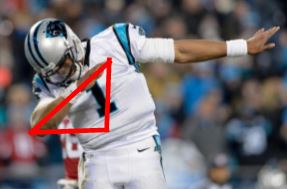
Each student had a ruler and made their own triangle for Cam’s dab on this handout:
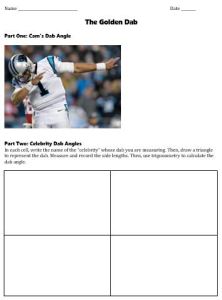
Download handout here: golden-dab-handout
Each student picked two side lengths and the appropriate trig ratio to use. We also had a brief discussion about similar triangles and why this method of using trig ratios based on side lengths measured from a picture would be comparable to measuring in real life. Lastly, we talked about the possibility of measuring errors and decided we were calculating “close enough” dab angles.
Then, students had the chance to choose 4 of the 6 “celebrities” located around the classroom to measure and calculate. My principal graciously dabbed for me and his image drew a large crowd.
Betty White had the smallest dab angle, around 20 degrees, and everyone agreed she was one of the best, but mostly because of who she is. Our principal’s was about 50 degrees and this also elicited a positive reaction.
I sensed that many students did not want to dab for Part 3, so I asked for volunteers and we all measured their dabs instead. Students used any of the 3 trig ratios they wanted (sine, cosine, or tangent) based on whichever side lengths of the triangle they measured.
At the end of class, I asked the big question, Is there a “Golden” Dab angle? The answer: 5/16 say yes. 11/16 a resounding no.
Here are the 5 student responses saying yes:
S1: 45 degrees. Because that is half of 90 degrees and that would be a perfect dab.
S2: I believe Cam Newton has the golden dab because he is closest to 45 degrees, 48. He looked like he knew what he was doing and looked confident, which meant he dabbed almost perfectly without overdoing it.
S3: The best dab angle is 30 to 40 degrees because it looks the cleanest.
S4: It is 45 degrees because you have maximum effect without overdoing it. You also look much cooler. While it is nearly impossible to know the exact angle while you’re doing it, you should try for 45 degrees. Practice makes perfect.
S5: It would be between 33-45 degrees because it looks the best and is the most common. But almost any angle could be a golden angle depending on the person.
General comments from the rest:
-Everyone is different and unique so for a dab to be “perfect” to you, you just have to have your own style.
-If you take another picture of the same person again, it wouldn’t have the same angle as before.
-There isn’t one exact way to do the dab.
-There isn’t one angle because everyone can dab however they want.
-There isn’t one because everybody’s arms are different lengths and people have different styles.
-It only depends on the person and confidence in doing it. They can’t seem like they’re trying too hard. The surrounding sometimes matters too.
-It all depends on someone’s surroundings, persona, swagger, and confidence. The dab depends on the person, therefore there is no golden dab angle.
We didn’t have time to work on the extension questions, but I am including them here in case someone else wants to use them.
• Can you dab at 30o? 60o? Which angle feels the most comfortable? The least? Why?
• Sketch a dab with an angle of 90o. Is this feasible in real life? Why or why not?
• If a person creates a 25o dab and their combined dab arm length is 44 inches, how high vertically would their hand be above the ground?
The conclusion: There isn’t a lot of math in this post, but there was a lot of math done in class. However, it seemed like a natural part of the conversation because we needed it to talk about a golden dab, but then collectively decided to throw it out the window as most students agreed there was no one right way to dab since everyone has their own style. But after closely comparing dabs, and ignoring personal style/confidence, many decided that 45 degrees made for a pretty good one. But the perfect one? A dab done with confidence.
This was the perfect activity to review finding angles using the trig ratios. If you try this with your students, please share how it goes! I’m curious how other students around the country view the second arm’s importance to the dab, and whether or not a 45 degree golden angle is upheld or not, or do we agree it’s all about your swagger?
